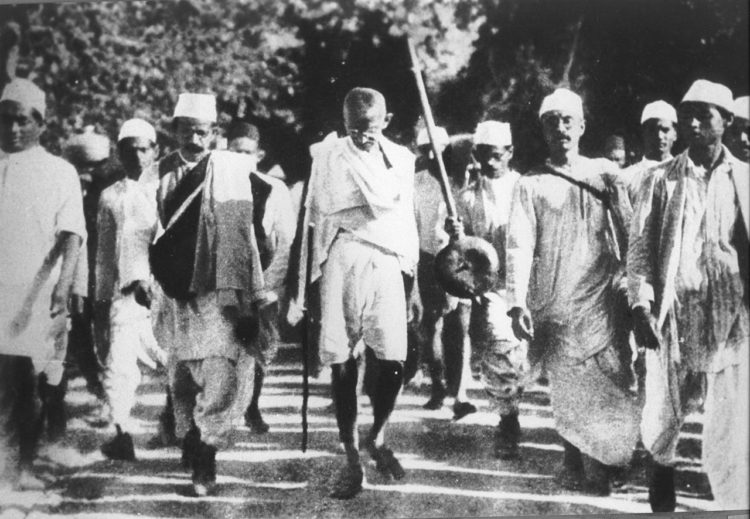Gandhi’s Philosophy of Nonviolence: Essential Selections
FEATURED RESEARCH PAPER, 30 Jun 2025
Brian C. Barnett | Academia - TRANSCEND Media Service
A concise open-access teaching resource featuring essential selections from Gandhi on the philosophy of nonviolence. The book includes: a preface, brief explanatory notes, supplementary boxes containing related philosophical material, images and videos, an appendix on post-Gandhian nonviolence, questions for reflection/discussion, and suggestions for further study.
2021 – Mohandas Karamchand Gandhi (1869–1948)—often addressed by the respectful “Gandhiji,” the reverential “Mahatma” (Sanskrit for “Great Soul”), or the affectionate “Bapu” (Gujarati for “father”)—is widely regarded as the father of nonviolence. 1 His birthday, October 2, is commemorated as the International Day of Nonviolence.
Of course, Gandhi was not the first to advocate nonviolence as a form of resistance to injustice. He drew on an expansive range of earlier sources, most notably the Jain religion, his own Hinduism, Christianity, the ancient Greek philosopher Socrates (469/470– 399 BCE), the ancient Greek and Roman Stoics, the US transcendentalists Ralph Waldo Emerson (1803–1882) and Henry David Thoreau (1817–1862), the Russian novelist and essayist Leo Tolstoy (1828– 1910), and the English writer, philosopher, and art critic John Ruskin (1819–1900).
Gandhi’s significance lies in synthesizing and building on these sources, developing new methods of nonviolent resistance, advocating for and publicizing these ideas and methods in writings and speeches, and putting them into practice on a massive, coordinated scale in South Africa and India, thereby providing a template on which many future nonviolent activists would model their own campaigns.
Most prominent among those he influenced was Martin Luther King, Jr. (1929–1968), a Baptist minister, activist, and spokesperson for the US civil rights movement. King studied philosophy, sociology, and theology as an undergraduate and in seminary, which prepared the way for his enthusiastic embrace of Gandhi’s ideas upon encountering them during doctoral studies. King then absorbed Gandhi’s writings, traveled to India to pay homage, and imported the Gandhian philosophy into the US context, where he adapted it to his Christianity, systematized and refined it, presented it to the public in an eloquent, powerful new voice, and wielded it in his fight for justice and against what he termed “the Triple Evils” of poverty, racism, and militarism.
Although Gandhi and King are no longer with us, the Gandhi-King paradigm lives on today in nonviolent resistance movements all over the world.
Download PDF file:
FEATURED RESEARCH PAPER STAYS POSTED FOR 2 WEEKS BEFORE BEING ARCHIVED
Tags: Gandhi, Nonviolence, Nonviolent Action, Research
DISCLAIMER: The statements, views and opinions expressed in pieces republished here are solely those of the authors and do not necessarily represent those of TMS. In accordance with title 17 U.S.C. section 107, this material is distributed without profit to those who have expressed a prior interest in receiving the included information for research and educational purposes. TMS has no affiliation whatsoever with the originator of this article nor is TMS endorsed or sponsored by the originator. “GO TO ORIGINAL” links are provided as a convenience to our readers and allow for verification of authenticity. However, as originating pages are often updated by their originating host sites, the versions posted may not match the versions our readers view when clicking the “GO TO ORIGINAL” links. This site contains copyrighted material the use of which has not always been specifically authorized by the copyright owner. We are making such material available in our efforts to advance understanding of environmental, political, human rights, economic, democracy, scientific, and social justice issues, etc. We believe this constitutes a ‘fair use’ of any such copyrighted material as provided for in section 107 of the US Copyright Law. In accordance with Title 17 U.S.C. Section 107, the material on this site is distributed without profit to those who have expressed a prior interest in receiving the included information for research and educational purposes. For more information go to: http://www.law.cornell.edu/uscode/17/107.shtml. If you wish to use copyrighted material from this site for purposes of your own that go beyond ‘fair use’, you must obtain permission from the copyright owner.
One Response to “Gandhi’s Philosophy of Nonviolence: Essential Selections”
Join the discussion!
We welcome debate and dissent, but personal — ad hominem — attacks (on authors, other users or any individual), abuse and defamatory language will not be tolerated. Nor will we tolerate attempts to deliberately disrupt discussions. We aim to maintain an inviting space to focus on intelligent interactions and debates.
Read more
Click here to go to the current weekly digest or pick another article:
FEATURED RESEARCH PAPER:

Gandhi is an idea of non-violence, non-exploitation, non-oppression, liberation and peace. But Gandhi is murdered every day, every moment he is assassinated.
Gandhi, Nonviolence and Peace
For Eradication of Corruption, Crime and Violence
By Surya Nath Prasad, Ph.D. – TRANSCEND Media Service
https://www.transcend.org/tms/2014/10/gandhi-nonviolence-and-peace/
Nonviolence: More Fundamental than Disarmament
Surya Nath Prasad, Ph. D. – TRANSCEND Media Service
https://www.transcend.org/tms/2016/08/nonviolence-more-fundamental-than-disarmament/